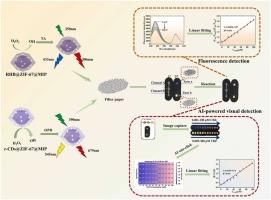人工智能纳米酶印迹荧光μPAD传感器用于多菌灵和噻苯达唑的现场同时视觉检测
IF 3.7
1区 化学
Q1 CHEMISTRY, ANALYTICAL
引用次数: 0
摘要
多菌灵(CBZ)和噻苯达唑(TBZ)是苯并咪唑类杀菌剂,在果树病害防治中应用广泛。然而,它们的过度使用严重威胁着生态环境和人类健康。需要开发一种便携式、快速的现场检测方法。本研究开发了一种基于纳米酶印迹荧光纸的双模微流控传感器,用于同时检测CBZ和TBZ。采用溶胶-凝胶法制备了基于过氧化物酶样沸石咪唑酸框架-67表面的分子印迹聚合物(RHB@ZIF-67@MIP和r-CDs@ZIF-67@MIP),对目标分析物进行了高选择性识别。将这两种印迹纳米酶分别组装到纸基微流体(μPAD)传感平台上,形成双通道印迹荧光μPAD传感器。采用过氧化氢(H2O2)/对苯二甲酸体系和H2O2/邻苯二胺体系两种不同的化学反应,构建了双比例荧光检测体系。结合智能手机和AI图像处理程序,在10分钟内完成对CBZ和TBZ的荧光检测、图像采集和实时分析。RHB@ZIF-67@MIP μPAD传感区在0.001 ~ 100 μM范围内对CBZ呈线性响应。而r-CDs@ZIF-67@MIP μPAD传感区在0.005 ~ 300 μM范围内具有有效的TBZ检测效果。人工智能驱动的荧光信号快速处理提高了分析效率。该纳米酶印迹荧光μPAD传感器具有灵敏度高、检测速度快、便携性好等特点,为苯并咪唑类农药残留的现场快速检测提供了一种新的方法。本文章由计算机程序翻译,如有差异,请以英文原文为准。

AI-powered nanozyme-imprinted fluorescence μPAD sensor for on-site simultaneous visual detection of carbendazim and thiabendazole
Carbendazim (CBZ) and thiabendazole (TBZ), belonging to benzimidazole fungicides, are widely applied in fruit disease control. However, their excessive use is severely threatening toward the ecological environment and human health. Developing a portable and rapid on-site detection method is required. In this study, a dual-mode nanozyme-imprinted fluorescence paper-based microfluidic sensor was developed for the simultaneous detection of CBZ and TBZ. Molecularly imprinted polymers based on the surface of peroxidase-like zeolitic imidazolate framework-67 (RHB@ZIF-67@MIP and r-CDs@ZIF-67@MIP) were respectively constructed by sol-gel method for highly selective recognition of target analytes. These two imprinted nanozymes were respectively assembled onto the paper-based microfluidic (μPAD) sensing platform to form a dual-channel imprinted fluorescence μPAD sensor. A dual-ratiometric fluorescence detection system was constructed by incorporating two distinct chemical reactions, namely the hydrogen peroxide (H2O2)/terephthalic acid system and the H2O2/o-phenylenediamine system. Integrating with a smartphone and an AI image processing program, fluorescence detection, image acquisition, and real-time analysis toward CBZ and TBZ were completed within 10 min. The RHB@ZIF-67@MIP μPAD sensing zone showed a linear response toward CBZ across 0.001–100 μM. While the r-CDs@ZIF-67@MIP μPAD sensing zone demonstrated effective TBZ detection across 0.005–300 μM. AI-powered rapid processing fluorescence signals enhanced analysis efficiency. The nanozyme-imprinted fluorescence μPAD sensor exhibits high sensitivity, rapid detection, and portability, providing a novel method for rapid on-site detection of benzimidazole pesticide residues.
求助全文
通过发布文献求助,成功后即可免费获取论文全文。
去求助
来源期刊

Sensors and Actuators B: Chemical
工程技术-电化学
CiteScore
14.60
自引率
11.90%
发文量
1776
审稿时长
3.2 months
期刊介绍:
Sensors & Actuators, B: Chemical is an international journal focused on the research and development of chemical transducers. It covers chemical sensors and biosensors, chemical actuators, and analytical microsystems. The journal is interdisciplinary, aiming to publish original works showcasing substantial advancements beyond the current state of the art in these fields, with practical applicability to solving meaningful analytical problems. Review articles are accepted by invitation from an Editor of the journal.
 求助内容:
求助内容: 应助结果提醒方式:
应助结果提醒方式:


